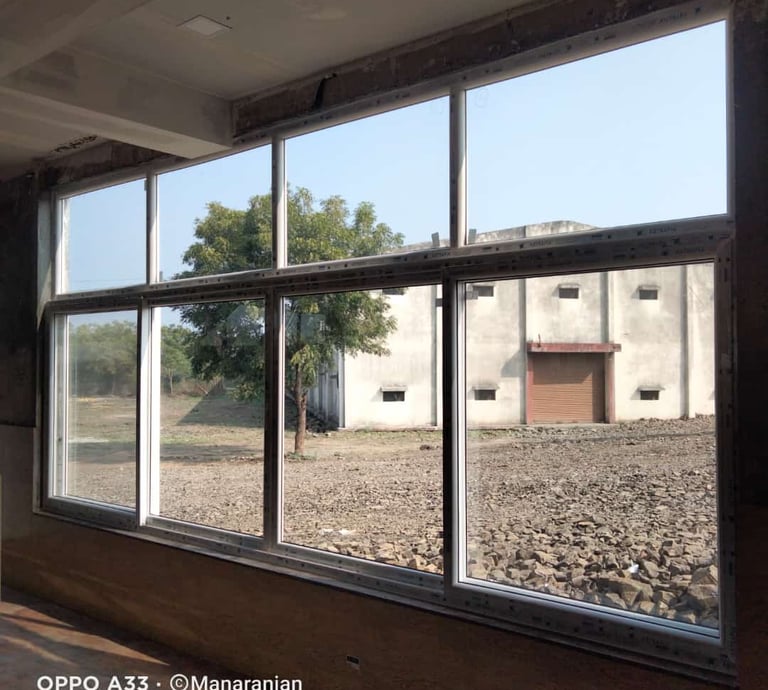Enjoy exclusive discounts on our stylish windows!
How uPVC Windows Withstand Bangalore’s Rainy Season
6/17/20253 min read


Introduction
Bangalore’s monsoon season is a mixed bag—it's both a blessing and a bit of a headache. While the rains provide a much-needed break from the sweltering summer heat, they also bring along high humidity, heavy downpours, and the dreaded water seepage. For homeowners with traditional window systems, this can mean a lot of maintenance headaches. That’s where uPVC windows come into play: they’re a modern, weather-resistant option designed to hold up even during the most intense monsoon storms. In this comprehensive guide, we’ll dive into why uPVC windows are the ideal choice for Bangalore’s rainy season. We’ll cover everything from the technical details and user benefits to real-life examples and expert recommendations.
1. Understanding How Bangalore’s Monsoon Affects Windows Monsoon Duration:
Bangalore experiences annual rainfall ranging from 970 mm to 1,200 mm, primarily occurring between June and October.
Challenges:
Water leaking through frames
Wooden frames warping and decaying
Metal frames rusting
Mold and mildew growth around frames and corners
Common Issues with Traditional Materials:
Wood : Swelling, warping, fungus
Aluminum : Condensation, corrosion
Steel : Rust, expansion
What is uPVC and Why It’s Monsoon-Proof uPVC, or Unplasticized Polyvinyl Chloride, is a tough, weather-resistant plastic that’s commonly used in construction. Unlike traditional materials like wood or metal, it won’t soak up moisture, rust, or warp over time.
Key Features That Make uPVC Perfect for Rain :
Moisture Resistance – uPVC is great at keeping water out, so it won’t swell or shrink.
Fusion-Welded Frames – These frames have no mechanical joints that can loosen or leak.
Multi-Point Locking System – This ensures a snug fit for the best sealing possible.
Integrated Drainage System – Built-in channels in the frames help direct water away.
Silicone Sealants and TPE Gaskets – These features work together to stop seepage, leaks, and even noise.
3. Built-In Drainage Systems in uPVC Windows
Most high-quality uPVC windows include:
Slope Design on Frame Base: Directs water to drain channels
Weep Holes: Let water exit the frame
Gasket Channels: Prevent water from reaching the inner edge
These mechanisms ensure rainwater is guided away from your home interior.
4. How uPVC Windows Prevent Mold & Mildew
Mold grows in moisture-laden environments—often around wooden or poorly sealed windows. Since uPVC windows are water-tight and non-absorbent, they prevent:
Damp spots on window frames
Mold growth in corners
Peeling paint due to water seepage
Plus, regular cleaning with a damp cloth is enough—no need for antifungal treatments or repainting.
5. Sealing Technology That Blocks Rain & Wind
uPVC windows use advanced sealing methods:
EPDM rubber gaskets – Maintain elasticity even in extreme weather
Double sealing systems – Two levels of protection against leakage
Pressure Equalization Chambers – Regulate airflow and pressure to maintain structural balance
These seals stop wind-driven rain from entering the home—a common issue in high-rise Bangalore apartments.
6. Real-World Performance in Bangalore Homes
Case Study: Whitefield Villa Community
After upgrading from wooden frames to uPVC windows, the residents saw:
Zero water leakage during July–August downpours
Less damp smell in closets and rooms
Significant reduction in maintenance costs
8. Maintenance Tips During Monsoon
Clean Drainage Holes Monthly: Use a small brush or cloth
Check Gaskets: Ensure rubber seals are soft and intact
Avoid Harsh Chemicals: uPVC is easy to clean with soap and water
Inspect for Obstructions: Keep the weep holes and frames debris-free
9. Expert Advice on Choosing the Right uPVC Windows in Bangalore
When shopping for uPVC windows, look for:
ISO-marked or EN-certified products
Minimum 2.2mm wall thickness
Reinforced steel core for high-wind areas
Experienced installers who offer waterproofing guarantees
10. Conclusion: Monsoon-Proof Your Home the Smart Way
If you're tired of leaks, swelling frames, and rainy-day woes, uPVC windows are the monsoon-proof upgrade your Bangalore home needs. Their superior design, zero-maintenance benefits, and long-term durability make them the go-to choice for homeowners, architects, and builders across the city.
Frequently Asked Questions (FAQs)
Q1: Can uPVC windows be installed during the rainy season?
Yes, installation can be done year-round. Installers usually schedule rain-free days for fitting.
Q2: Do uPVC windows prevent condensation?
Yes. When combined with double-glazing, uPVC windows minimize indoor condensation.
Q3: Are these windows termite-proof?
Yes. uPVC is not susceptible to termites or insects like wood.
Q4: How long do uPVC windows last in Bangalore's climate?
With proper installation, they can last 20–30 years with little to no maintenance.
Contact us to Explore the Range of UPVC Windows & Doors
info@astrapia.net
08069409604
© 2025. All rights reserved.
24x7 CUSTOMER CARE NO:
Bengaluru
Belagavi
Nagpur
Bhubneswar
Head-Office
# 38, Nanjappa Layout,Somashettihalli,Bengaluru - 560090
